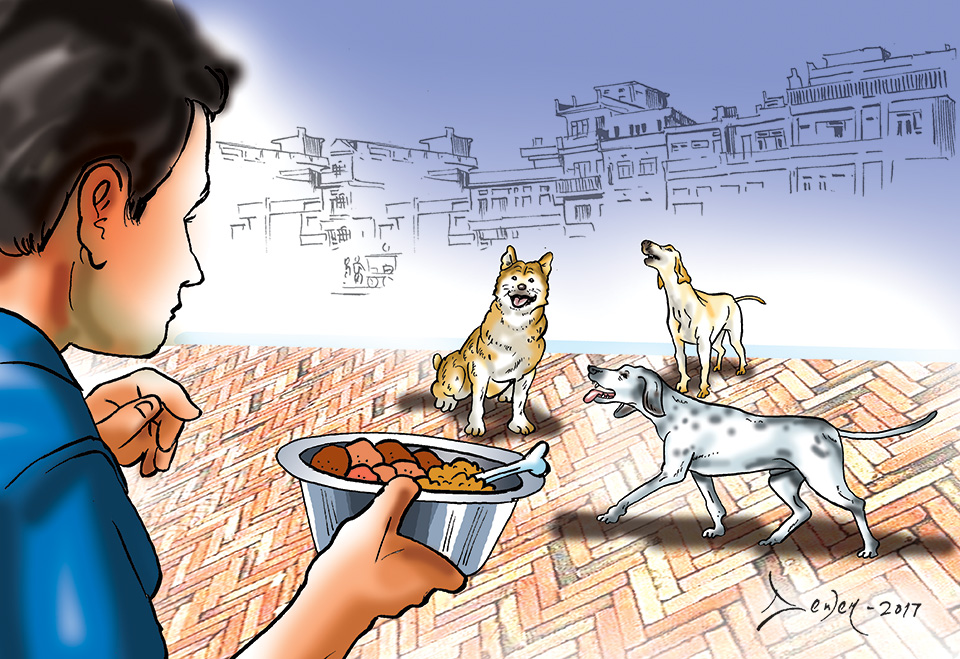Cham: The Dance Meditation (With Video)
5 years ago

5 years ago

5 years ago

5 years ago

5 years ago

5 years ago

KATHMANDU, August 27: While many of us seek peace by paying a daily visit to temples and offering respect to the idols that rule as a form of god, 36-year-old Manoj Shakya finds solace in feeding more than a hundred of stray dogs daily. He has been doing this for the past eight years.
A local resident of Patan, Manoj earns a living through metal carving. He started feeding stray dogs when he used to run a tuition center with his wife in Indra Chowk, Kathmandu. He used to regularly feed a dog, which gradually grew to feeding a pack of stray dogs on a daily basis. In earlier times, he would feed stray dogs around his home and workplace. However, owning a scooter after three years of feeding street dogs helped him expanded his feeding stations to most places in Kathmandu city.
Every night at 10:30, he leaves his home with a bucket full of packed food items and eight liters of water. The food that he carries includes four kgs of beaten rice with minced meat. Each night, he feeds more than 100 stray dogs in 19 different places of the city. It takes him almost three hours to complete the feeding process and costs him a daily expense of Rs 500.
Nevertheless, all he gathers from the deed is an immense pleasure that in a way makes his life meaningful. “Feeding street dogs has become a ritual to me and I can’t let go of it now. Whenever the work schedule gets hectic, my wife encourages me to continue my work and takes it upon her to feed the dogs,” said Manoj.
In these eight years, he has failed to feed the dogs only a couple of times during the 2015 Gorkha Earthquake. A scooter accident a few years ago didn’t stop him from feeding the dogs. He made sure his wife follows the ritual.
“Feeding stray dogs is one of the ways that I can contribute to ensure their welfare. But efforts by a few individuals will not suffice in the long-run. A collaborative effort should be made in order to ensure pets’ welfare, which could also lessen the threats caused by street dogs. Moreover, it is crucial for the pet owners to discontinue abandoning their pets on the streets,” he said.
After the official ban on killing street dogs in 2015, the Kathmandu Metropolitan City in collaboration with Human Society International (HIS) and The Jane Goodall Institute Nepal (JGI Nepal) have adopted a provision to sterilize street dogs. It is estimated that there are around 21,856 street dogs in the valley.
Of the total dog population, 20 percent female and five percent male dogs have been neutered. The three-year campaign launched in March 2016 aims to sterilize and vaccinate street dogs in all 32 wards of the city.
“We have been running a local community group that monitors any unusual behavior of local stray
dogs and vaccinates them if required,” said Chief of Public Health Division, Hari Shrestha. “KMC runs a program in an operation center in Teku that sterilizes up to 40 male and female street dogs each day,” he added.
The campaign for sterilizing dogs has been going in full swing which is a better approach to ensure both public health and welfare of the street dogs. “The decreasing number of street dogs itself contributes to their welfare as the limited number can get the needed attention and are easily checked upon for vaccination,” says Dr Prabin Thapa, veterinarian coordinator of Humane Society International.
According to the program initiated by Kathmandu Metropolitan City being based on pet welfare, the five freedoms that confirm animal welfare are Freedom from Hunger and Thirst, Freedom from Pain, Injury and Disease, Freedom from Discomfort, Freedom from Fear and Distress and Freedom to Express Normal Behavior.
Shakya’s individual approach has improved the lives of hundreds of street dogs and collaborative approaches adopted by the organizations have further ensured their betterment. Since animal welfare is confirmed by the fulfillment of these five freedoms, it stands significant that we address all of these requirements to create a favorable environment for both the social beings -- humans and animals -- to stay in cohesion.
Leave A Comment